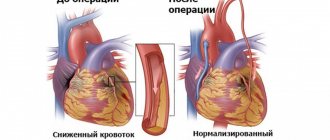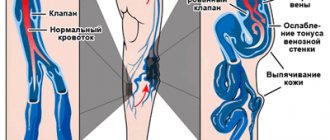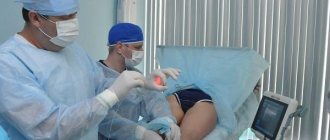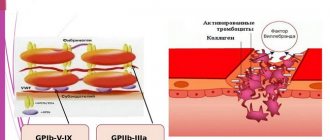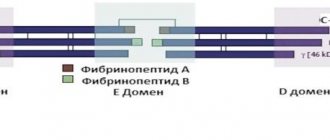In most cases, what a phlebologist treats and who he is, people find out only when there is an urgent need to make an appointment with this specialist. Despite the fact that phlebology is a “narrow” branch of angiology, it is a fairly broad medical specialization. What do phlebologists do? They specialize in diagnosing the condition of veins, developing treatment regimens, and also preventing the occurrence and progression of various lymphatic and venous pathologies. Phlebologists are the same as vascular surgeons. The only difference is that they specialize in varicose veins and other diseases of the veins of the lower extremities.
Why is it so important to contact a phlebologist on time?
Blood circulates in the body in a strictly defined direction in a closed cycle. Safety valves protect it from reverse movement. If they begin to function incorrectly, blood, under the influence of gravity, is retained in the lower part of the body, mainly in the legs. As a result, the walls of blood vessels may lose tone and become deformed. This is how varicose veins develop and thicken. Due to impaired blood circulation in these places, over time the vessels may become inflamed, which can lead to phlebitis. First of all, the pathology manifests itself in the legs, in the groin. Slowing blood flow and damaging vessel walls can lead to blood clots. If one of them comes off, then with the bloodstream it can enter the lungs through the right chambers of the heart or the inferior vena cava. This, in turn, can cause thromboembolism (blockage) of the pulmonary arteries and be fatal. That is why it is very important to consult a phlebologist in a timely manner.
Ultrasound scanning: modern technique. Mechanism of operation and diagnostic capabilities
Vascular Doppler ultrasound is a classic ultrasound technique based on the Doppler effect. According to this effect, the frequency and wavelength of radiation, which is perceived by the receiving apparatus, changes due to the movement of either the radiation source or the receiving apparatus itself. In other words, ultrasound equipment picks up impulses that are reflected from red blood cells in the blood. The nature of blood flow is studied by how the frequency and length of ultrasonic waves reflected from them are distorted. The study also allows you to visualize the walls of blood vessels.
Find out more about the promotion >>>
Ultrasound scanning of the lower extremities is one of the most accurate methods for studying the condition of veins and arteries. It allows you to evaluate the performance of blood vessels, their patency, see blood clots, narrowed areas, atherosclerotic plaques, and measure the speed of blood flow. The doctor receives an image of high clarity and contrast, which, coupled with advanced information processing technologies on modern equipment, allows:
- detect atherosclerotic changes up to 1.1 mm in size, with accuracy reaching 98%;
- assess the condition and operation of the valves, the elasticity of blood vessels;
- calculate the size of the blood clot, enlarge its image many times;
- measure the required parameters as accurately as possible, thanks to the automatic quality optimization option;
- track the changes that were achieved during treatment, because the received information about the patient is stored in the computer memory and can be viewed without restrictions;
- detect pathologies at the earliest stages for treatment without consequences.
Ultrasound scanning can detect the following diseases:
- Deep vein thrombosis . The equipment “sees” blood clots attached to the walls of blood vessels, accurately determines their location and assesses the likelihood that they will break off. As a result, complications such as pulmonary artery blockage, stroke and subsequent paralysis and even death can be avoided.
- Atherosclerosis . Atherosclerotic plaques are deposits of calcium and fat on the walls of blood vessels. Without treatment, they grow, which leads to loss of elasticity of the walls of blood vessels, and this disrupts blood flow and leads to hypertension. Ultrasound scanning allows you to see plaques at the very beginning of their formation.
- Postthrombotic syndrome . Ultrasound scanning in this case is necessary for people who have had acute thrombosis of deep veins. Based on the diagnostic results, complete information is obtained about the operation of the venous valves and blood flow.
- Aneurysm . This disease is a protrusion of the vessel wall, which occurs due to its stretching and thinning. The danger lies in the absence of symptoms and the likelihood of aneurysm rupture, which can be fatal. Ultrasound scanning makes it possible to see changes that have just begun in a timely manner.
- Varicose veins Using ultrasound, they determine how dilated and elongated the veins are, whether (and where) there are areas with excessively thin walls and nodes, as well as the stage of the disease. Based on the results, the doctor will prescribe treatment and assess the need for surgery.
The study has no contraindications or restrictions; no preparation is required for it. During the procedure, a contact gel is applied to the skin of the patient’s legs, which increases the permeability of ultrasound signals. Then the specialist moves the sensor over the skin in the areas where the blood vessels are projected. The resulting image is displayed in real time on a computer monitor.
What is the difference between a vascular surgeon and a phlebologist?
When it becomes necessary to make an appointment with a doctor who treats venous diseases, the question arises: what is the difference between a phlebologist and a vascular surgeon (angiosurgeon). Some are sure that there is no difference. However, it is worth understanding how the specializations of these doctors differ. An angiosurgeon is approached to treat congenital or acquired vascular diseases of the entire body. What does a phlebologist treat? He specializes in vascular pathologies of the lower extremities, as well as complications associated with them (for example, trophic ulcers). So, if you contact an angiosurgeon with varicose veins of the lower extremities, he will most likely redirect you to a phlebologist.
What are the advantages of treating vein diseases in our clinical centers?
- The colossal combined experience of our phlebologists is more than 15,000 operated patients.
- Excellent diagnostic base and examination protocols. The most experienced ultrasound diagnostic specialists work in our clinics.
- A full-fledged hospital for vascular and endovascular surgery with the possibility of microsurgical operations on venous valves.
- A program for monitoring and managing patients in the postoperative period with free correction of possible relapses.
- We solve all vascular problems in our patients, from spider veins to heart attacks.
- A program for creating a loyal environment in the patient community, when your friends are provided with more favorable conditions for treatment.
- Direct contact with your phlebologist, when the doctor leaves you a personal phone number for urgent communication.
- Opportunities for interactive consultations using the website, independent choice of time to sign up for a re-examination after treatment.
When you may need the help of a phlebologist
To avoid serious consequences, it is necessary to make an appointment with a doctor in a timely manner and begin therapy. Self-medication is not only ineffective, but sometimes even dangerous. Only a qualified specialist can prescribe a treatment method that is adequate to the current condition. So, you should contact a phlebologist if you have the following symptoms:
- heaviness in the legs, severe fatigue after walking;
- cramps of the calf muscles, especially often manifested at night;
- swelling of the legs;
- visual enlargement of veins;
- pain and burning in the legs;
- the appearance of spider veins, as well as blue or red vessels visible under the skin.
Varicose veins are a fairly common disease, especially among women over 40. Many people know about the disease, but few are aware of the existence of an entire science that studies this disease and everything related to pathology. Modern phlebology takes on this responsibility.
What is phlebology? What does she treat?
Phlebology is a field of medicine that studies the structure of the venous network of the human body, the reasons for the decline in its functions, the symptoms of venous insufficiency and treatment methods. This area had to be separated into a separate science due to the widespread prevalence of venous diseases, and the length of the history of pathology is impressive.
Coverage of the medical field or what is within the competence of a phlebologist.
Despite the fact that phlebology is a narrow specialization of cardiovascular surgery, a phlebologist has extensive knowledge of the physiology of the entire human body. A specialist in the field in question deals with the following pathological processes:
Phlebeurysm. A disease associated with decreased elasticity of the vein walls. Individual sections of the venous network increase in size, which leads to disruption of the entire venous system. Among those suffering from pathology are representatives of all age groups, even children, who are treated by specialists in pediatric phlebology;
Venous thrombosis. It is characterized by the formation of blood clots in some sections of the vein, the latter blocking the blood flow, thereby affecting the entire vein;
Phlebitis. We are talking about inflammation of the venous walls. The course of the disease is accompanied by pathological changes in the walls of blood vessels. Over time, the patient develops thrombophlebitis;
Thrombophlebitis. With the disease, in addition to the formation of blood clots, an inflammatory process develops in the vein. The disease is rarely treated with conservative methods, but in most cases the help of a surgeon is required;
Trophic ulcers. Advanced form of varicose veins. The condition is accompanied by disruption of tissue nutrition, inflammation and depletion of the skin with the formation of ulcers. The disease is difficult to treat;
Venous bleeding. The most severe form of varicose veins, which is characterized by the possibility of bleeding from minor microtraumas in places where the veins are swollen;
Chronic venous insufficiency. The disease is accompanied by a decrease in the efficiency of blood outflow in the lower extremities, transformation of the saphenous veins;
Phlebopathy , spider veins, etc.
When should you contact a phlebologist?
If signs of pathological conditions are detected, you must promptly consult a doctor. The table below lists the main “alarm bells” that may indicate the development of one of the ailments described above:
| Pathology | Characteristic signs |
| Varicose veins of the legs |
|
| Varicose veins of the pelvis |
|
| Phlebitis |
|
| Thrombophlebitis |
|
Next, we’ll talk about when it’s worth contacting a phlebologist on an ongoing basis (annually). We are talking about patients at risk.
Among them:
- representatives whose work activities involve a high load on the limbs (hairdressers, athletes, dancers, etc.);
- office workers (with a sedentary lifestyle);
- women who have given birth to children (the more pregnancies and births a patient has had, the higher the risk of problems with veins);
- overweight people;
- patients with a hereditary predisposition to diseases of this type.
This group also includes patients who have undergone any type of vein surgery. Regular monitoring by a phlebologist will help avoid relapse of the disease.
Methods for diagnosing vascular diseases
Once in the phlebologist’s office, the patient undergoes a visual examination and answers the doctor’s questions. Then the doctor carries out further diagnosis of vascular diseases. The list of specific measures depends on the characteristics of the clinical case.
Among the main diagnostic procedures performed to make a diagnosis:
duplex scanning. We are talking about an ultrasound examination, during which the shape of the veins, their diameter, lumen and blood flow speed through the venous network are assessed;
Dopplerography. Alternative type of ultrasound;
Phlebography. The procedure consists of an x-ray, as a result of which the structure of the veins and the speed of blood flow are assessed;
Phlebomanometry. Invasive method for measuring intravenous pressure;
Phleboscintigraphy. A thorough examination of the veins, accompanied by the administration of a radiopharmaceutical.
As part of a preventive examination, they resort to duplex scanning or Doppler sonography.
Diagnostics in the field of adult and pediatric phlebology also includes standard tests. We are talking about a general and biochemical blood test. The latter helps to assess the level of cholesterol, triglycerides, etc. In addition, a urine test is indicated. For more detailed diagnostics, they resort to submitting biological material to determine the concentration of potassium, sodium, and chlorides.
Treatment methods.
Depending on the stage of development of the disease, specialists use conservative or surgical treatment methods. In the first case, resort to the following measures:
- taking medications (phleboprotectors, anti-inflammatory, anticoagulants);
- using ointments and creams to relieve symptoms;
- wearing compression garments;
- the use of physiotherapeutic procedures (electrophoresis, ozone therapy, etc.);
- diet;
- carrying out therapeutic exercises.
If it is impossible to eliminate the consequences of the disease using conservative methods, surgical intervention is resorted to. During the treatment process, the trunk of the saphenous vein is removed, deep vein plastic surgery is performed, or blood flow is reduced.
Since varicose veins are characterized by several stages of development, the treatment methodology at each stage differs.
The first stage of the disease - sclerotherapy will help.
In the first stage of varicose veins, surgery as such is not performed in phlebology. In this case, sclerotherapy is preferred. The essence of the procedure is the injection of a special drug into a vein. During the process, the specialist uses very thin needles. If thick veins are affected, the liquid injection is replaced with foam.
At the following stages, the following manipulations are carried out:
EVLO
Laser treatment for varicose veins has appeared relatively recently. This method allows you to effectively treat varicose veins using a laser. A more precise name for this technique is endovasal laser coagulation. You consider this effect on the veins to be one of the most effective. The operation time is about 40 minutes. Rehabilitation after it lasts no more than 4 hours or is not required at all.
INDICATIONS FOR EVLO
The operation is performed only if there are certain indications:
- pronounced varicose transformation;
- dilatation of the great saphenous vein;
- bending of the main venous trunk;
- trophic disorder of the leg.
ADVANTAGES AND DISADVANTAGES OF LASER THERAPY
First, let's look at the advantages of this treatment method:
- cosmetic properties (no incisions during surgery); • fast execution;
- short rehabilitation period;
- control of all actions via ultrasound, which improves the quality of the operation;
- minimum discomfort after surgery;
- absence of hematomas and bruises after surgery;
- low probability of relapse;
- very low probability of postoperative numbness of the limbs; • full ability to work after the procedure;
- low rate of complications;
- low probability of infection. The disadvantages of this procedure include the cost - an expensive operation. But the effect that is achieved with its help is worth all the money spent. Among the disadvantages, one can note the fact that with a large diameter of the saphenous vein, treatment using this method without incisions is absolutely impossible.
CONTRAINDICATIONS TO EVLO
Like any treatment method, laser therapy has contraindications. You can find out about contraindications depending on your health status from your doctor. General contraindications for surgery are as follows:
- diseases that require urgent medical intervention; • oncological diseases;
- thrombophlebia;
- pregnancy;
- breastfeeding period;
- severe expansion of the saphenous veins;
- chronic arterial insufficiency. If these contraindications exist, surgery is not recommended.
CARRYING OUT OPERATION USING LASER
Such treatment should be carried out in stages. Successful treatment depends not only on the doctor’s experience, but also on a number of other important factors. The first step is local anesthesia. During the operation, a catheter is inserted into the patient's varicose vein. Then a very thin laser light guide is inserted into the catheter. All manipulations are carried out under careful control using duplex scanning. After this, the doctor turns on the laser, performs treatment and slowly removes the light guide from the vein. Upon completion of the procedure, a compression pad made of special, adhesive bandages is applied, and elastic knitwear is put on top of it.
POSTOPERATIVE COMPLICATIONS
Numerous studies confirm that EVLO - laser treatment of varicose veins has virtually no complications, especially when we compare this method of treatment with other types of surgery to get rid of varicose veins. Complications include the following factors, which usually appear in the first days after treatment:
- bruises;
- small painful lumps;
- thrombosis;
- thrombophlebitis;
- burns;
- hematomas;
- skin pigmentation;
- neurological disorders.
Almost all of these complications are extremely rare, many of them go away on their own and quickly enough. It is not for nothing that the procedure is considered safe and low-traumatic; no rehabilitation is required after it, and an hour after its completion the patient can leave the clinic on his own.
COMBINING EVLO WITH PHLEBECTOMY
After performing an ultrasound duplex scan of the condition of the veins, it may be revealed that EVLO is impossible due to the large diameter of the great saphenous vein. In this case, phlebectomy is performed together with laser coagulation. During this procedure, one small incision is made. This is the best alternative to conventional surgery. Before the operation, epidural anesthesia is performed. At the very beginning, the doctor makes a small (1.5 cm) incision in the groin. The affected vein is ligated through this incision. This procedure helps prevent the recurrence of varicose veins. Through the same incision, a light guide is inserted into the vein. Then laser coagulation is performed. If necessary, the ducts of the small or great saphenous vein are removed through a micropuncture using the miniphlebectomy method, and scleropathy can be performed. But no matter what surgical interventions are performed, they will all be done through a single incision in the groin area.
MAIN ADVANTAGES OF THE COMBINED METHOD
Among the advantages of this technique, it is worth noting the following:
- low risk of recurrence of varicose veins;
- low morbidity during surgery;
- beneficial cosmetic results. But this method also has its disadvantages:
- the need for epidural anesthesia;
- the need to make an incision to access the vein.
Sclerosation of telangiectasia.
For sclerotherapy of telangiectasias, the microsclerotherapy method is used. This procedure allows you to introduce a special solution into the cavity of even the smallest vessel. During the procedure, the doctor injects a special substance – sclerosant – into the pathological vessel. This substance, entering the vessel, causes a burn to the cavity and destroys the walls of the capillaries. After which the vessel sticks together and turns into a fibrous cord. The duration of this procedure is no more than 20-30 minutes. There are some limitations to sclerotherapy for telangiectasia.
This procedure is not recommended if:
- there are untreated venous refluxes (varicose veins);
- there is a tan on the body.
After microsclerotherapy:
- in some cases, wearing compression garments is recommended (3-5 days);
- you can return to your daily life. In case of removal of telangiectasia on the legs, it is recommended to walk more;
- exclude staying in the pool, sauna, bathhouse, as well as exposure to the sun for two weeks after the procedure;
- when visiting the gym, avoid strength training for 5 days after the procedure;
- If bruises appear, treat them with heparin-containing ointments 2 times a day for two weeks. To obtain the best possible result, you need to carry out 1 to 3 microsclerotherapy procedures with an interval of 1 - 1.5 months.
Our clinic invites you to undergo these procedures. Every year we carry out a large number of such medical procedures. We employ highly qualified specialists with extensive experience. The clinic is also equipped with the most modern equipment for diagnosing various vascular pathologies.
Who may be at risk for phlebological diseases
Those who are at risk should be especially attentive to their health:
- persons whose relatives suffer from hereditary diseases of the venous vessels;
- To old people;
- persons who lead a sedentary lifestyle;
- people whose professional activities involve constant sitting;
- persons who abuse alcohol and have other bad habits;
- pregnant women (in particular, it is recommended to consult a doctor in the second or third trimester);
- persons whose professional activities involve heavy loads on their legs;
- people who have problems with excess weight.
Diagnostic methods in the field of phlebology
During the consultation, the vascular and vein doctor finds out the history of the disease, conducts an examination, and prescribes an examination.
Laboratory tests are performed to determine blood clotting parameters and identify the risk of blood clots.
The “gold standard” of instrumental diagnostics is ultrasound in duplex scanning mode. This method allows you to see changes in the wall and valves of the vessel, places of narrowing and the presence of blood clots, assess blood flow and identify pathological blood discharge.
The study does not require patient preparation. It is carried out in a lying position, standing, with the “coughing” technique.
Diagnosis of phlebological diseases
As with many other diseases, timely diagnosis is of great importance. If venous disease of the lower extremities is identified at an early stage, it will be much easier to cope with it. So, the doctor may prescribe the following examinations - coagulogram, spiral computed tomography, ultrasound angioscanning, X-ray contrast venography. This allows you to assess the quality of blood flow and determine the nature of vascular pathologies. Taking into account the results of the examination and the severity of the disease, the phlebologist will prescribe the necessary treatment methods and subsequent rehabilitation in a particular case.
What does a phlebologist treat?
A phlebologist deals with the treatment and prevention of the following pathologies and conditions:
- varicose veins;
- phlebitis;
- phlebothrombosis;
- thrombophlebitis;
- thrombosis;
- disorders caused by blood clots;
- chronic venous insufficiency;
- trophic ulcers;
- venous dysplasia;
- pathology of the pelvic veins;
- bleeding due to varicose veins;
- improper development of veins;
- and etc.
All this applies to the lower extremities.
Find out more about the promotion >>>
How to make an appointment
To get to a phlebologist at a medical clinic, click the “Self-book an appointment” button in the upper right corner of the page. Then fill out the short information form. To do this, provide all the necessary information: name, contact phone number, convenient date and time of appointment, and also select a clinic where it will be convenient for you to undergo the examination. In addition, you can make an appointment with a phlebologist by calling any phone number from the “Contacts” section. Our specialists will clarify prices, tell you about payment terms and answer all your questions.
What worries you?
- varicose veins
- Pain and heaviness in the legs
- Spider veins
- Lymphedema
- Swelling of the legs
- varicose veins
Innovative treatment methods that are being developed by phlebological science:
- Conservative – new pharmacological drugs are being developed that can strengthen the venous wall
- Sclerosurgical – elimination of reticular (subcutaneous) varicose veins using FOAM-FORM sclerotherapy with CO2 gas under Venovisor
- Endovascular – elimination of main varicose veins using endovenous laser coagulation EVLT and radiofrequency ablation RFA
- Preventive – creation and improvement of compression hosiery, thinner, more durable and more comfortable
The desire to maintain one’s health is inherent in almost every person. This is why phlebology is so in demand today . Moscow is a large metropolis in which human physical activity is limited, and the number of negative factors is disproportionately large. The number of venous diseases of the human lower extremities is increasing every day.
Expert-level phlebologists working at MIFC, the Medical Innovative Phlebological Center, strive to solve the problem and help the maximum number of patients.
What should the patient expect after completion of the diagnosis?
The examination provides valuable information about the condition of the venous system. Some patients find out that there is nothing wrong with their veins. This category receives recommendations on further lifestyle, preventive measures, and is referred to specialists of another profile in the presence of other pathologies. For patients with venous pathology, depending on the stage of the disease, an individual treatment regimen is prescribed. It is a combination of radical and conservative techniques. Unfortunately, varicose veins cannot be cured only with the help of the latter. But don’t worry, modern phlebology allows for radical treatment of even advanced forms of varicose veins using the following minimally invasive techniques:
- Endovenous laser obliteration.
- Microphlebectomy.
- Sclerotherapy.
The above treatment methods have proven themselves well in both domestic and global phlebological practice.
Where does it take
When applying, there are several factors to consider:
- doctor's experience in this specialty;
- experience in the field of phlebology;
- specialist category;
- availability of residency or internship in vascular surgery.
Patients are accepted in specialized private and public clinics, where modern equipment is located.
Specialized phlebology clinics are equipped with innovative diagnostic and treatment systems.
There are two ways to get an appointment with a specialist:
- Having received a referral from the local physician to the diagnostic center;
- or for paid services.
Paid consultation
An initial doctor's appointment costs on average 1,200 rubles. The price depends on:
- fame of the clinic;
- doctor's name;
- region of the Russian Federation.
In some regions the price ranges from 2000 rubles. The services are not cheap.
After receiving consultation, it is necessary to undergo a series of tests to detect the disease.
Cost of services of a phlebologist surgeon in Moscow.
The cost of treatment by a phlebologist surgeon with many years of experience and extensive work experience should not be low, in addition, sometimes there are advertisements that a phlebologist surgeon in Moscow gives consultations for free. No self-respecting clinic will work for free or at a loss. Any services of a phlebologist surgeon are worth something. And if this is a good center, then it will be equipped with expensive equipment, and all related materials (consumables, dressings) will be disposable. This is an important rule of infection safety, followed by leading clinics in the world. Therefore, the service provided by a phlebologist surgeon in Moscow and the price for it cannot be very low.
The average cost, for example, of endovascular thermal ablation of veins, which is performed by a phlebologist surgeon in Moscow, in a serious clinic, varies from 50,000 to 100,000 rubles. If the cost of endovasal intervention is low, then you should think about how the clinic management can save money. The cost of the operation is calculated from many factors, but the main ones are: the price of equipment, the price of imported disposable consumables and the experience of the leading vascular surgeons and phlebologists of this center.
One of the advantages of our clinic is the price of visiting an expert-level phlebologist surgeon; it is quite affordable and accessible to any category of patients.
| Service | Treatment category | Price |
| Appointment with an expert phlebologist with ultrasound scanning of the veins of the lower extremities | 2900₽ 3500₽ | |
| Appointment with an expert phlebologist without ultrasound scanning of the veins of the lower extremities (based on ultrasound results from another clinic) | 2000₽ 2400₽ | |
| Appointment with an expert phlebologist with ultrasound examination based on the results of treatment for one year | for free |
For the convenience of our patients, we work with banks that offer credit lines. Also in our center there is a flexible system of discounts and installments. Payment by Visa and Mastercard is possible. At the end of the course of treatment, the patient is given a package of documents to submit to the tax office for tax deduction.
Until now, patients who have been suffering from venous diseases for a long time ask on the Internet “advise how to find a phlebologist surgeon” or “advise a good phlebologist surgeon”, “where to find leading phlebologist surgeons at affordable prices.” We will not talk about ourselves that we are the best phlebologists in Moscow. Patient reviews will tell you everything about our doctors.
Phlebologist surgeon in Moscow - reviews from our grateful patients!
Patient's review of surgeon-phlebologist Semenov A.Yu.
Natalya Berdnikova, Moscow region, Sofrino, 06.16.2019
Dear Artem Yurievich! I would like to express my deep gratitude to you for the EVLO GSV surgery performed with Varadi miniphlebectomy on the lower leg and thigh. I am immensely glad and happy that I came to you for an appointment and treatment.
After a difficult birth, a lump appeared under the knee, varicose veins, a hereditary predisposition, pronounced veins, heaviness in the legs and constant fatigue bothered me. For 28 years she was indecisive, and the disease progressed. Diagnosis: varicothrombophlebitis. I was very lucky that I was in the safe hands of such a wonderful phlebologist as Artem Yurievich Semenov. Truly, a doctor from God! My life is saved! The operation was completely painless. After finishing all the procedures, as in a fairy tale, she stood up and walked with her own legs. Artem Yuryevich, low bow to you, you again gave me lightness and freedom of movement! THANK YOU so much for being you, for your wonderful attitude towards people, for your kind heart, for your invaluable work. Natalya Berdnikova, Moscow region, Sofrino, June 16, 2021
Patient's review of the surgeon-phlebologist, Ph.D. Raskine V.V.
Igor Osipenko, Moscow, 05/29/2018
I was diagnosed with varicose veins on my right leg in November 2021. I don’t have the habit of putting off solving health problems, so I immediately started looking for a clinic to perform the operation. I looked at reviews of clinics, compared ratings of surgeons on various websites and forums. As a result, the choice fell on MIFC. After 6 months after the operation, I can say with complete confidence that I was not mistaken in my choice. I am grateful to doctors Vladimir Vyacheslavovich Raskin and Artem Yurievich Semenov for their excellent work. The operation was successful, the postoperative period was smooth, and real professionals couldn’t have it any other way. I liked the clear organization of the process: initial examination, preoperative preparation, surgery, postoperative support. Special thanks to administrator Tatyana - she is the first to meet patients, and from the very first minutes of communication with her it becomes clear that in this clinic you will not be left without care and attention.” Igor Osipenko, Moscow, May 29, 2021
A patient's review of the wonderful surgeon-phlebologist Antipov A.A.
Vologina Alexandra, November 8, 2018, Smolensk
I would like to express my great (enormous) gratitude to the wonderful doctor Alexey Alexandrovich Antipov for a well-performed operation (EVLT), for his attentive attitude towards patients, for his sense of humor! At each subsequent appointment I go to Alexey Alexandrovich with pleasure, and not because I need to. In general, I was very afraid of the operation, I was scared to go, but everything went very well, thanks to the professional and coordinated work of these specialists.
And now my life is divided into “before” the operation and “after”. I finally felt like a full-fledged woman, not ashamed of myself, my legs!!! I am happy to demonstrate this. Thank you very much!!! Your grateful patient, Alexandra Vologina from Smolensk, November 08, 2021.
Phlebectomy
This is an operation to remove pathologically dilated veins. Currently, laser techniques for vein surgery have been developed and introduced into clinical practice. The surgical intervention is performed under local anesthesia and is absolutely painless. 2-3 hours after the procedure, the patient is discharged for outpatient observation. In some cases, a so-called classic operation to remove a pathologically dilated vein and its tributaries is indicated. The most reliable in some cases is a combination of 2 methods.
